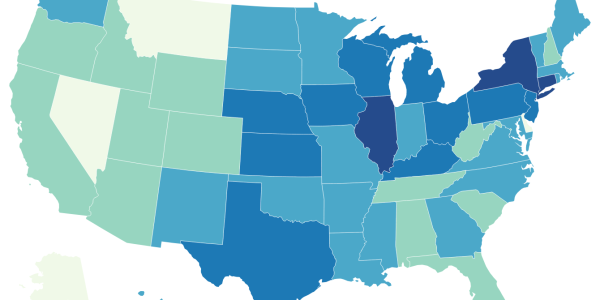
Much was made of the so-called tech exodus from California to lower-tax Texas during the COVID-19 pandemic. But a new report finds it’s not quite as good of a deal as many think.
Though Texas has no state-level personal income tax, it does levy relatively high consumption and property taxes on residents to make up the difference. Ultimately, it has a higher effective state and local tax rate for a median U.S. household at 12.73% than California’s 8.97%, according to a new report from WalletHub.
“When people are like, ‘Oh California is so much more expensive than Texas,’ that’s the top income tax rate. That’s on people earning over $1 million,” says Richard Auxier, senior policy associate in the Urban-Brookings Tax Policy Center. “If you’re looking at average people, the income tax burden is never going to be that big. The systems were not designed that way.” And Auxier points out there are often deductions and credits that help to lower income tax.
WalletHub’s report calculated what the tax burden would be on the median income earner across the country. The report breaks it down by median income in the U.S. and the median income in each state. It also assumes the median earner owns a median-valued home, a car valued at $26,220, and spends “an amount equal to the spending of a household earning the median U.S. income,” in order to calculate property tax, vehicle tax, and sales and excise tax burdens.
The typical Illinois family pays the most state and local taxes, according to the report, at 15.05% of their income. Connecticut, New York, Pennsylvania, and Kansas round out the top five states with the highest effective state and local tax rates for the median resident.
Meanwhile, Alaska residents pay the least in state and local taxes, percentage-wise, with 6.05% of their income going toward that tax burden. Delaware, Montana, Nevada, and Wyoming are also on the lower end.
Of the nine states without a state income tax, five have higher effective state and local tax rates on the median income than California according to WalletHub's calculation, including New Hampshire, South Dakota, Tennessee, Texas, and Washington.
'Taxes are inherently difficult to suss out'
Of course, WalletHub's calculations aren't perfect. There are any number of ways to measure tax burdens, and they will vary significantly from person to person and household to household. WalletHub's calculations offer one perspective, but every study omits some variables that will make a difference.
"Taxes are inherently difficult to suss out because they are inherently personal," says Auxier. Family size, marital status, home ownership, age, number of children—there are tons of factors that affect any person's actual tax burden.
Property taxes are especially complicated to calculate. Not everyone owns a home, to start. And property taxes vary widely, even within the same state, depending on when a person bought their home.
In fact, using U.S. median prices, especially home prices, in every state as WalletHub's report does is misleading, says Jared Walczak, vice president of state projects at the Tax Foundation. While California's property tax rates are low, its home values are much higher than the national median figure used for the calculations. When comparing effective rates with state-adjusted figures, Walczak says California and Texas actually end up having fairly similar tax burdens: Texas at 11.8%, and California at 11.4%.
"California has genuinely low property tax rates, period," says Walczak. "But when you look at that and say California's effective rates are half of Texas's, it doesn't take into account that property costs in California are more than double Texas’s."
Whether you have a children also makes a huge difference in your tax burden.
"If you earn $50,000, a single person has a higher tax burden than a married couple with three children earning $50,000," says Auxier. "There’s so much variance within these averages."
WalletHub's report does put some things into perspective: While many people would point to states without a state income tax as "low tax," it's largely people on the upper end of the income spectrum who get the most out of it.
California, New York, and DC have programs like the Earned Income Tax Credit "which, literally send money to low and middle income tax people," says Auxier. "States like Texas don't have that."
Still, the report can provide one snapshot of different tax burdens.
"It does make sense to think of this holistically, to think about your income, sales, and excise tax together," says Walczak. "But you need to take state-by-state differences in costs into account."




